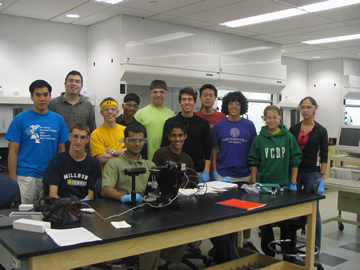 |
New Jersey Governor's School in the Sciences at Drew University |
 |
Drew Links |
|
| Team Projects | |
| NJGSS Home | |
| About NJGSS | |
Related Links |
|
| Drew University | |
2006 Team 2 |
||||||||
CAN WE DEVELOP THE NEW TEFLON? DEVELOPING COATINGS AND LOOKING AT SURFACE MOLECULAR DYNAMICS Sachin Amrute, Kateryna Christian, Husain Danish, Karina DeMair, Patrick Gorman, Christopher Hollyday, Joshua Israel, Allen Lin, Vrajesh Modi, Justin Petrillo, Steven Schwartz Advisors: Gloria Anderle and Michael Avaltroni
|
||||||||
ABSTRACTTeflon has become one of the most widely used compounds in industry since its invention in 1938. Several problems with Teflon, however, have arisen in recent years including an EPA report labeling Teflon and other fluorocarbon compounds as potential carcinogens. Octadecyl-phosphonic acid (ODPA) has shown to be a potential replacement for Teflon; it covalently bonds with the oxide surface in a self-assembled monolayer, exhibits the same properties as Teflon and is one of the few compounds that can bond with the titanium oxide surface. In this study, ODPA was bonded onto silicon dioxide surface through different methods including the T-BAG-Tethering by Growth and Aggregation-method, mayer rod application, drain submersion, drip method and spray method. In addition, different heat application methods were experiment with including the heat gun, iron, infrared light, ultraviolet light, and oven. The efficacy of the application methods were determined by contact angle measurements using water drops. Mayer rod application with iron heating proved to be the most effective method of application. To support the results and to gain a better understanding of the surface chemistry, computer models were developed which simulated the phosphonic acid molecule and the oxide surface. It is advised that further studies be conducted in this field to optimize the efficiency of coating surface layers. Keywords : self-assembled monolayers (SAM), surface coatings, octadecylphosphonic acid (ODPA), oxide surfaces, contact angle, T-BAG (Tethering by Growth and Aggregation) |
||||||||
|
||||||||
